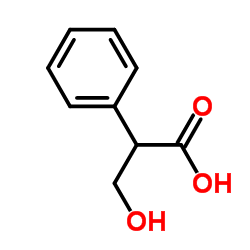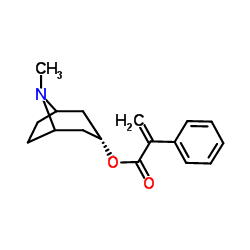5908-99-6
| 中文名 | 硫酸阿托品 |
|---|---|
| 英文名 | Atropine sulfate monohydrate |
| 中文别名 | 硫酸DL-莨菪碱 |
| 英文别名 |
MFCD00074815
AtropineSulphateGrPuriss Atropina Solfato racemic anisodamine atropine sulphate atropin sulfate Atropsiol AtropineSulfat TROPINI SULFAS ATROPINI SULFAS Atropt Atropinsulfat EINECS 200-235-0 |
| 描述 | Atropine硫酸一水合物是毒蕈碱乙酰胆碱受体拮抗剂。 |
|---|---|
| 相关类别 | |
| 参考文献 |
| 沸点 | 429.8ºC at 760mmHg |
|---|---|
| 熔点 | 189-192 °C (A)(lit.) |
| 分子式 | C17H25NO7S |
| 分子量 | 387.45 |
| 闪点 | 213.7ºC |
| PSA | 191.75000 |
| LogP | 4.10130 |
| 外观性状 | 白色粉末 |
| 储存条件 | 避光,阴凉干燥处,密封保存 |
| 稳定性 | 常温常压下稳定,无色结晶体或白色结晶体粉末。熔点为190-194℃。其1g晶体能溶于0.4ml水、2.5ml沸醇、5ml醇、2.5ml甘油、420ml氯仿、3000ml乙醚。无臭,有风化性,遇光易变质。味极苦。剧毒。 |
| 水溶解性 | soluble |
| 计算化学 | 1、 疏水参数计算参考值(XlogP): 1、 疏水参数计算参考值(XlogP): 2、 氢键供体数量:5 3、 氢键受体数量:13 4、 可旋转化学键数量:10 5、 互变异构体数量: 6、 拓扑分子极性表面积(TPSA):75 7、 重原子数量:48 8、 表面电荷:0 9、 复杂度434 10、 同位素原子数量:0 11、 确定原子立构中心数量:4 12、 不确定原子立构中心数量:2 13、 确定化学键立构中心数量:0 14、 不确定化学键立构中心数量:0 15、 共价键单元数量:4 |
| 更多 | 1. 性状:未确定 2. 密度(g/mL,25/4℃):未确定 3. 相对蒸汽密度(g/mL,空气=1):未确定 4. 熔点(ºC):189-192 5. 沸点(ºC,常压):未确定 6. 沸点(ºC,5.2kPa):未确定 7. 折射率:未确定 8. 闪点(ºC):未确定 9. 比旋光度(º):未确定 10. 自燃点或引燃温度(ºC):未确定 11. 蒸气压(kPa,25ºC):未确定 12. 饱和蒸气压(kPa,60ºC):未确定 13. 燃烧热(KJ/mol):未确定 14. 临界温度(ºC):未确定 15. 临界压力(KPa):未确定 16. 油水(辛醇/水)分配系数的对数值:未确定 17. 爆炸上限(%,V/V):未确定 18. 爆炸下限(%,V/V):未确定 19. 溶解性:未确定 |
Synonym:None known Section 2 - COMPOSITION, INFORMATION ON INGREDIENTS
Risk Phrases: 26/28 Section 3 - HAZARDS IDENTIFICATION EMERGENCY OVERVIEW
Very toxic by inhalation and if swallowed.Light sensitive.The toxicological properties of this material have not been fully investigated. Potential Health Effects Eye: May cause eye irritation. May cause lacrimation (tearing), blurred vision, and photophobia. Skin: May cause skin irritation. May cause skin rash and eruptions. Ingestion: May cause irritation of the digestive tract. The toxicological properties of this substance have not been fully investigated. Ingestion of large amounts may cause pain, constipation or diarrhea. May cause an abrupt rise in body temperature, convulsions, and coma. Ingestion may cause headache, nausea, and vomiting. Inhalation: May cause respiratory tract irritation. The toxicological properties of this substance have not been fully investigated. May cause cardiovascular disturbances, hearing abnormalities, central nervous system depression, muscle weakness, and possible death due to respiratory failure. Chronic: Exposure to large doses may cause central nervous system depression. Section 4 - FIRST AID MEASURES Eyes: Flush eyes with plenty of water for at least 15 minutes, occasionally lifting the upper and lower eyelids. Get medical aid. Skin: Get medical aid. Flush skin with plenty of water for at least 15 minutes while removing contaminated clothing and shoes. Wash clothing before reuse. Ingestion: Never give anything by mouth to an unconscious person. Get medical aid. Do NOT induce vomiting. If conscious and alert, rinse mouth and drink 2-4 cupfuls of milk or water. Inhalation: Remove from exposure and move to fresh air immediately. If not breathing, give artificial respiration. If breathing is difficult, give oxygen. Get medical aid. Do NOT use mouth-to-mouth resuscitation. Notes to Physician: Section 5 - FIRE FIGHTING MEASURES General Information: As in any fire, wear a self-contained breathing apparatus in pressure-demand, MSHA/NIOSH (approved or equivalent), and full protective gear. During a fire, irritating and highly toxic gases may be generated by thermal decomposition or combustion. Extinguishing Media: Use agent most appropriate to extinguish fire. Use water spray, dry chemical, carbon dioxide, or appropriate foam. Section 6 - ACCIDENTAL RELEASE MEASURES General Information: Use proper personal protective equipment as indicated in Section 8. Spills/Leaks: Vacuum or sweep up material and place into a suitable disposal container. Clean up spills immediately, observing precautions in the Protective Equipment section. Avoid generating dusty conditions. Provide ventilation. Section 7 - HANDLING and STORAGE Handling: Wash thoroughly after handling. Use with adequate ventilation. Minimize dust generation and accumulation. Avoid contact with eyes, skin, and clothing. Keep container tightly closed. Avoid ingestion and inhalation. Store protected from light. Storage: Store in a tightly closed container. Store in a cool, dry, well-ventilated area away from incompatible substances. Store protected from light. Section 8 - EXPOSURE CONTROLS, PERSONAL PROTECTION Engineering Controls: Facilities storing or utilizing this material should be equipped with an eyewash facility and a safety shower. Use adequate ventilation to keep airborne concentrations low. Exposure Limits CAS# 5908-99-6: Personal Protective Equipment Eyes: Wear appropriate protective eyeglasses or chemical safety goggles as described by OSHA's eye and face protection regulations in 29 CFR 1910.133 or European Standard EN166. Skin: Wear appropriate protective gloves to prevent skin exposure. Clothing: Wear appropriate protective clothing to prevent skin exposure. Respirators: A respiratory protection program that meets OSHA's 29 CFR 1910.134 and ANSI Z88.2 requirements or European Standard EN 149 must be followed whenever workplace conditions warrant respirator use. Section 9 - PHYSICAL AND CHEMICAL PROPERTIES Physical State: Crystalline powder Color: white Odor: None reported. pH: Not available. Vapor Pressure: Not available. Viscosity: Not available. Boiling Point: Not available. Freezing/Melting Point: 189.00 - 192.00 deg C Autoignition Temperature: Not applicable. Flash Point: Not applicable. Explosion Limits, lower: Not available. Explosion Limits, upper: Not available. Decomposition Temperature: Solubility in water: soluble Specific Gravity/Density: Molecular Formula: C34H46N2O6.H2SO4.H2O Molecular Weight: 694.85 Section 10 - STABILITY AND REACTIVITY Chemical Stability: Stable under normal temperatures and pressures. Conditions to Avoid: Incompatible materials, light, dust generation, excess heat. Incompatibilities with Other Materials: Oxidizing agents. Hazardous Decomposition Products: Nitrogen oxides, carbon monoxide, oxides of sulfur, irritating and toxic fumes and gases, carbon dioxide, nitrogen. Hazardous Polymerization: Has not been reported. Section 11 - TOXICOLOGICAL INFORMATION RTECS#: CAS# 5908-99-6 unlisted. LD50/LC50: Not available. Carcinogenicity: Atropine Sulfate Monohydrate - Not listed by ACGIH, IARC, or NTP. Section 12 - ECOLOGICAL INFORMATION Section 13 - DISPOSAL CONSIDERATIONS Dispose of in a manner consistent with federal, state, and local regulations. Section 14 - TRANSPORT INFORMATION IATA Shipping Name: ALKALOID SALTS, SOLID, N.O.S.* Hazard Class: 6.1 UN Number: 1544 Packing Group: II IMO Shipping Name: ALKALOID SALTS, SOLID, N.O.S. Hazard Class: 6.1 UN Number: 1544 Packing Group: II RID/ADR Shipping Name: ALKALOID SALTS, SOLID, N.O.S. Hazard Class: 6.1 UN Number: 1544 Packing group: II Section 15 - REGULATORY INFORMATION European/International Regulations European Labeling in Accordance with EC Directives Hazard Symbols: T+ Risk Phrases: R 26/28 Very toxic by inhalation and if swallowed. Safety Phrases: S 1 Keep locked up. S 25 Avoid contact with eyes. S 28A After contact with skin, wash immediately with plenty of water. S 37 Wear suitable gloves. S 45 In case of accident or if you feel unwell, seek medical advice immediately (show the label where possible). WGK (Water Danger/Protection) CAS# 5908-99-6: No information available. Canada None of the chemicals in this product are listed on the DSL/NDSL list. CAS# 5908-99-6 is not listed on Canada's Ingredient Disclosure List. US FEDERAL TSCA CAS# 5908-99-6 is not listed on the TSCA inventory. It is for research and development use only. SECTION 16 - ADDITIONAL INFORMATION N/A |
|
生态学数据: 该物质对环境可能有危害,对水体应给予特别注意
|
| 符号 |

GHS06 |
|---|---|
| 信号词 | Danger |
| 危害声明 | H300 + H330 |
| 警示性声明 | P260-P264-P284-P301 + P310-P310 |
| 个人防护装备 | Eyeshields;Faceshields;full-face particle respirator type N100 (US);Gloves;respirator cartridge type N100 (US);type P1 (EN143) respirator filter;type P3 (EN 143) respirator cartridges |
| 危害码 (欧洲) | T+:Verytoxic; |
| 风险声明 (欧洲) | R26/28;R36/37/38;R43 |
| 安全声明 (欧洲) | S23-S45-S36/37/39-S26-S1 |
| 危险品运输编码 | UN 1544 6.1/PG 2 |
| WGK德国 | 2 |
| RTECS号 | CK2455000 |
| 包装等级 | II |
| 危险类别 | 6.1 |
| 海关编码 | 29399900 |
| 海关编码 | 29399900 |
|---|




